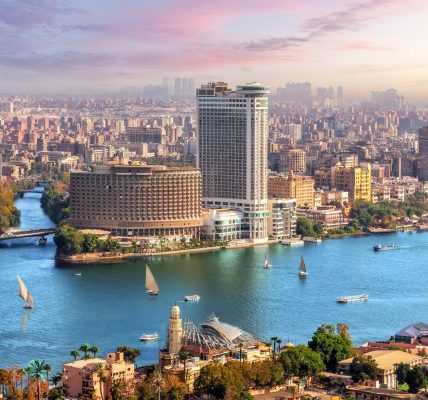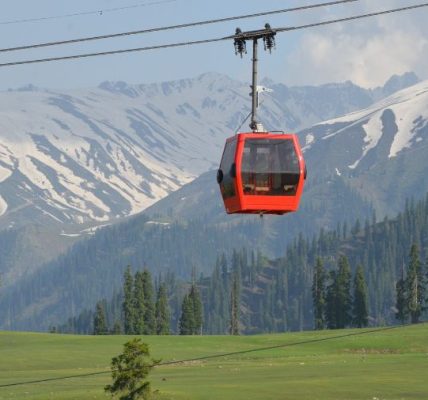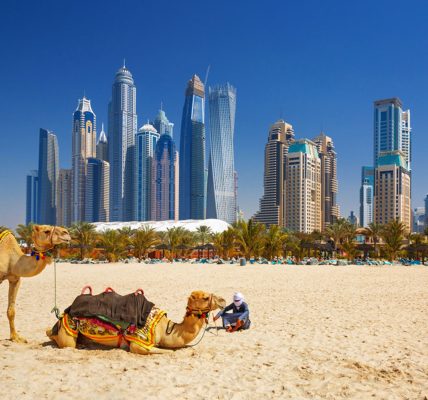-
Table of Contents
Lights, camera, adventure! Explore the reel world with Film Tourism.
Film tourism, also known as movie tourism or set-jetting, is a growing trend that involves visiting locations where movies or TV shows were filmed. It offers enthusiasts the opportunity to explore iconic sites and immerse themselves in the stories and worlds depicted on the silver screen. Film tourism has gained popularity due to the desire to experience the magic of cinema firsthand and the ability to connect with beloved characters and narratives in a tangible way. This form of tourism not only provides a unique travel experience but also contributes to local economies by promoting destinations and attracting visitors from around the world. In this article, we will delve into the fascinating world of film tourism, exploring the allure of visiting movie locations and the impact it has on both travelers and the film industry.
Famous Film Locations: A Guide to Visiting Iconic Movie Sets
Film Tourism: Exploring Locations and Stories from the Silver Screen
Famous Film Locations: A Guide to Visiting Iconic Movie Sets
Movies have the power to transport us to different worlds, to make us believe in the impossible, and to leave a lasting impact on our lives. From the bustling streets of New York City to the enchanting landscapes of New Zealand, film locations have become a major draw for tourists seeking to immerse themselves in the magic of the silver screen. In this guide, we will take you on a journey to some of the most iconic movie sets around the world, allowing you to step into the shoes of your favorite characters and relive the unforgettable moments that captured your imagination.
One of the most famous film locations is the Wizarding World of Harry Potter in London, England. Fans of J.K. Rowling’s beloved series can visit the Warner Bros. Studio Tour to explore the actual sets used in the films. From the Great Hall of Hogwarts to Diagon Alley, visitors can walk in the footsteps of Harry, Ron, and Hermione, and even try their hand at casting spells with a wand. The attention to detail is astounding, and it truly feels like stepping into the magical world of Harry Potter.
For those who prefer a taste of adventure, a trip to New Zealand is a must. The breathtaking landscapes of this country served as the backdrop for the epic “The Lord of the Rings” and “The Hobbit” trilogies. From the rolling hills of the Shire to the majestic peaks of Mount Doom, fans can embark on guided tours that take them to the exact locations where these iconic films were shot. It’s a chance to witness the beauty of Middle-earth firsthand and to relive the epic battles and heartwarming moments that captivated audiences worldwide.
If you’re a fan of classic movies, a visit to the Paramount Pictures Studio in Los Angeles, California is a must. This historic studio has been the birthplace of countless iconic films, from “Gone with the Wind” to “The Godfather.” Guided tours offer visitors a behind-the-scenes look at the sets, soundstages, and backlots where movie magic happens. You can walk down the same streets where your favorite characters once roamed and gain insight into the filmmaking process that brought these timeless stories to life.
For those seeking a taste of the exotic, a trip to Morocco is a must. This North African country has been the setting for numerous films, including “Gladiator” and “Lawrence of Arabia.” The vibrant markets of Marrakech, the ancient city of Ait Benhaddou, and the vast Sahara Desert have all played starring roles in these cinematic masterpieces. Guided tours allow visitors to explore these iconic locations, immersing themselves in the rich culture and history of Morocco while reliving the unforgettable moments that unfolded on the silver screen.
Film tourism offers a unique opportunity to connect with our favorite movies on a deeper level. It allows us to step into the world of our beloved characters, to experience the magic firsthand, and to create lasting memories. Whether you’re a die-hard fan or simply appreciate the art of filmmaking, visiting iconic movie sets is an experience like no other. So pack your bags, grab your camera, and get ready to embark on a journey that will transport you from the comfort of your living room to the enchanting worlds of the silver screen.
Uncovering the Real Stories Behind Blockbuster Films: Film Tourism and Historical Accuracy
Film Tourism: Exploring Locations and Stories from the Silver Screen
In recent years, film tourism has become a popular trend among travelers seeking to immerse themselves in the magic of the movies. From visiting iconic filming locations to uncovering the real stories behind blockbuster films, this form of tourism offers a unique and exciting way to explore the world. One aspect of film tourism that has gained particular interest is the historical accuracy of films and the opportunity to delve deeper into the real events that inspired these cinematic masterpieces.
When it comes to historical accuracy in films, there is often a delicate balance between staying true to the facts and creating an engaging narrative. Filmmakers are faced with the challenge of condensing complex events into a two-hour movie while still capturing the essence of the story. As a result, some historical inaccuracies are inevitable. However, this does not mean that film tourism cannot provide valuable insights into the real stories behind these movies.
One example of film tourism and historical accuracy intertwining is the case of the film “Schindler’s List.” Directed by Steven Spielberg, this powerful film tells the story of Oskar Schindler, a German businessman who saved the lives of over a thousand Jewish refugees during the Holocaust. While the film received critical acclaim for its portrayal of this heroic act, it also sparked interest in the real-life events that inspired it.
Visitors to Krakow, Poland, where much of the film was shot, can explore the remnants of the Krakow Ghetto and visit the factory where Schindler employed Jewish workers. These locations provide a tangible connection to the events depicted in the film and offer a glimpse into the lives of those affected by the Holocaust. While the film may not be entirely historically accurate, it serves as a starting point for further exploration and understanding of this dark chapter in history.
Another film that has sparked interest in historical accuracy is “Braveheart,” directed by Mel Gibson. This epic tale of Scottish warrior William Wallace has captivated audiences with its sweeping landscapes and intense battle scenes. However, historians have criticized the film for its many inaccuracies, including the portrayal of Wallace as a freedom fighter.
Despite these inaccuracies, film tourism related to “Braveheart” has flourished in Scotland. Visitors can explore the stunning landscapes of the Scottish Highlands, where much of the film was shot, and learn about the real history of Scotland’s fight for independence. While the film may not provide a completely accurate account of these events, it has undoubtedly sparked interest in Scottish history and encouraged travelers to delve deeper into the real stories behind the film.
Film tourism offers a unique opportunity to explore the world through the lens of cinema. While historical accuracy may sometimes be compromised for the sake of storytelling, this does not diminish the value of film tourism in uncovering the real stories behind blockbuster films. By visiting filming locations and delving deeper into the history that inspired these movies, travelers can gain a deeper understanding of the events depicted on the silver screen.
In conclusion, film tourism provides a fascinating way to explore the world and uncover the real stories behind blockbuster films. While historical accuracy may sometimes be compromised, the opportunity to visit filming locations and learn about the events that inspired these movies is invaluable. Whether it’s exploring the Krakow Ghetto in Poland or venturing into the Scottish Highlands, film tourism allows travelers to immerse themselves in the magic of the movies while gaining a deeper understanding of the real history behind them. So, grab your popcorn and embark on a cinematic adventure like no other.
The Impact of Film Tourism on Local Economies: Case Studies and Analysis
Film Tourism: Exploring Locations and Stories from the Silver Screen
The Impact of Film Tourism on Local Economies: Case Studies and Analysis
Film tourism, the phenomenon of travelers visiting locations that have been featured in movies, has become increasingly popular in recent years. This unique form of tourism allows movie enthusiasts to step into the world of their favorite films and experience the magic of the silver screen firsthand. However, film tourism is not just a thrilling experience for fans; it also has a significant impact on local economies. In this section, we will explore case studies and analyze the economic benefits that film tourism brings to various destinations.
One notable example of the economic impact of film tourism is the case of New Zealand. The country’s breathtaking landscapes served as the backdrop for the Lord of the Rings and Hobbit trilogies, attracting hordes of fans from around the world. The influx of tourists eager to explore the real-life Middle-earth has had a profound effect on the local economy. According to a study conducted by the New Zealand Institute of Economic Research, film tourism generated an estimated $1.1 billion in additional spending between 2001 and 2013. This surge in revenue has created job opportunities and stimulated growth in various sectors, including hospitality, transportation, and retail.
Similarly, the success of the Harry Potter franchise has had a significant impact on the economy of the United Kingdom. The Warner Bros. Studio Tour London – The Making of Harry Potter has become a must-visit destination for fans of the series. The tour allows visitors to explore the actual sets, props, and costumes used in the films, providing an immersive experience like no other. This attraction has not only boosted tourism in the area but has also created employment opportunities for local residents. In fact, a report by VisitBritain revealed that the Harry Potter franchise contributed £920 million to the UK economy in 2016 alone.
Another fascinating case study is the impact of film tourism on the city of Dubrovnik, Croatia. The city’s stunning medieval architecture served as the backdrop for King’s Landing in the hit television series Game of Thrones. As a result, Dubrovnik has experienced a surge in tourism, with fans flocking to see the real-life setting of their favorite show. This influx of visitors has revitalized the local economy, with businesses catering to the needs of tourists thriving. According to the Dubrovnik Tourist Board, the number of visitors to the city increased by 10% in 2016, directly attributed to the popularity of Game of Thrones.
While film tourism undoubtedly brings economic benefits to destinations, it is not without its challenges. The sudden influx of tourists can put a strain on local infrastructure and resources. In some cases, the authenticity and charm of a location may be compromised as it becomes overrun with visitors. Therefore, it is crucial for destinations to strike a balance between capitalizing on the popularity of film tourism and preserving the integrity of their cultural heritage.
In conclusion, film tourism has a significant impact on local economies, as demonstrated by the case studies of New Zealand, the United Kingdom, and Dubrovnik. The allure of visiting locations featured in beloved films and TV shows attracts a steady stream of tourists, generating revenue and creating job opportunities. However, it is essential for destinations to manage the challenges that come with film tourism to ensure the long-term sustainability of their economies and cultural heritage.Film tourism is a growing trend where travelers visit locations that have been featured in movies. This form of tourism allows fans to immerse themselves in the world of their favorite films and experience the magic of the silver screen firsthand. By exploring these locations, tourists can not only enjoy the stunning scenery but also connect with the stories and characters that have captivated audiences worldwide. Film tourism offers a unique and exciting way to travel, combining the thrill of visiting iconic movie sets with the joy of discovering new destinations. As this trend continues to gain popularity, it is expected to have a significant impact on the tourism industry, benefiting both travelers and the locations that serve as backdrops for beloved films.




